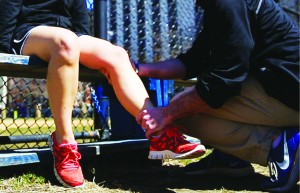
Stress Fractures FAQ
Leave a CommentA stress fracture can be one of the most irritating injuries to a runner. When one receives the diagnosis of a stress fracture, the injury will sideline a runner for an average of six weeks. This means no running at all, and most often runners must wear a boot or use crutches. Here are some frequently asked questions to about causes of stress fractures and the pain associated with the injury.
 What exactly is a stress fracture?
What exactly is a stress fracture?
A stress fracture is a small crack in any of the weight bearing bones of the body. The most commonly injured areas of runners are the tibia, or shinbone, and foot.
When am I most likely to get a stress fracture?
Stress fractures happen most often when runners increase their intensity and mileage over several weeks to a few months.
What does a stress fracture feel like?
A stress fracture typically feels like a dull ache along the bone. The pain usually feels localized to the specific spot of the fracture. Typically, it will hurt it you press on it. The pain will get progressively worse as you run on the injury, and it may even hurt if you jump on it.
What should you do if you feel like you might have a stress fracture?
You should visit your physical therapist for a complimentary injury screen and/or visit your physician so he or she can order x-rays or even a MRI to confirm the diagnosis of a stress fracture.
What is the treatment for a stress fracture?
There is no real treatment other than rest. As mentioned above, your physician may prescribe you a boot or crutches to help keep the pressure off the affected area. This allows for complete healing of the fracture. It is very important to follow the instructions of your physician. If you continue to run and put pressure on your stress fracture it can lead to a real bone fracture that would keep you sidelined for months and may result in surgery.
How can you prevent a stress fracture?
Evaluate your current training program. Make sure your mileage is not increasing dramatically. Typically, the average increase of distance over a week’s period time is 10 percent. You should also include “cut back” weeks with less mileage. Consider doing some strength training in order to help prevent this injury. Strengthening of your hips, core, quads, and calves can help prevent stress fractures as well. You can find strengthening exercises here.
